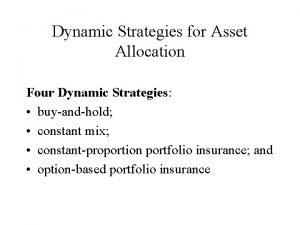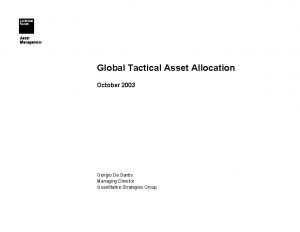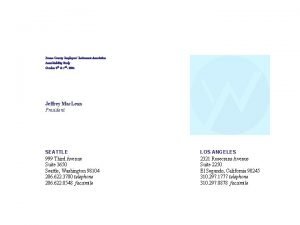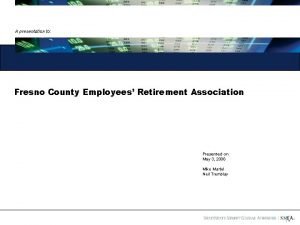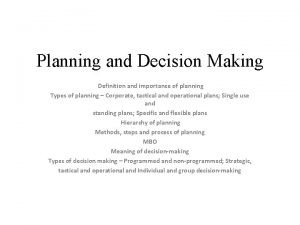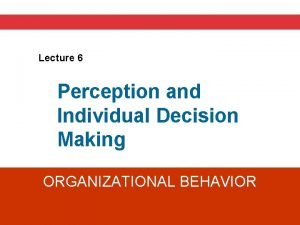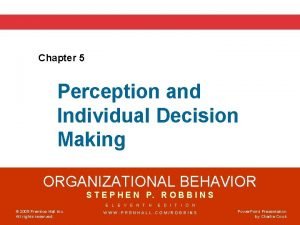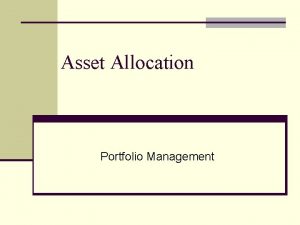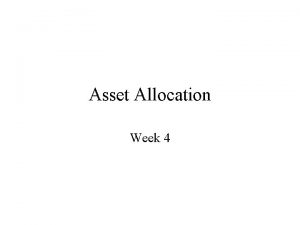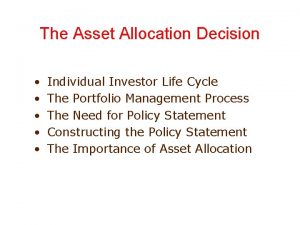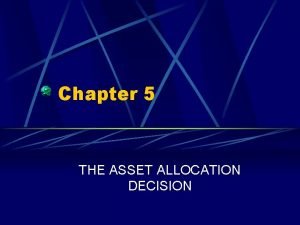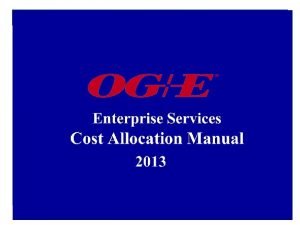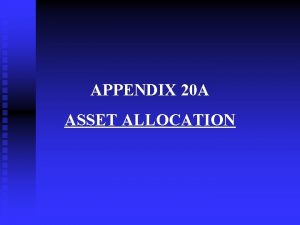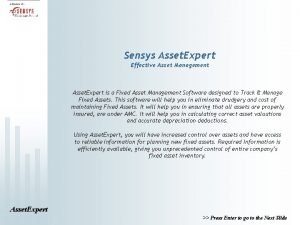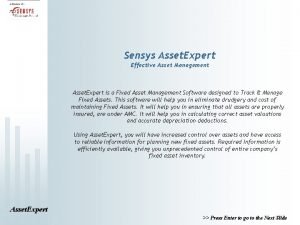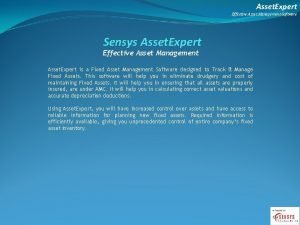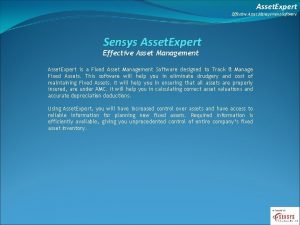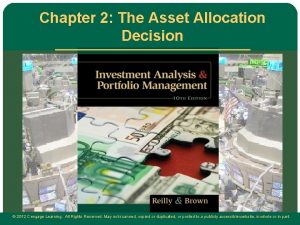Chapter 2 The Asset Allocation Decision 1 Individual





















- Slides: 21

Chapter 2 The Asset Allocation Decision 1

Individual Investor Life Cycle Exhibit 2. 1 Net Worth Accumulation Phase Consolidation Phase Spending Phase Gifting Phase Long-term: Retirement Children’s college Short-term: House Car Long-term: Retirement Short-term: Vacations Children’s College Long-term: Estate Planning Short-term: Lifestyle Needs Gifts Age 2

The Portfolio Management Process Exhibit 2. 2 1. Policy statement (road map)- Focus: Investor’s short -term and long-term needs, familiarity with capital market history, and expectations 2. Examine current and projected financial, economic, political, and social conditions - Focus: Short-term and intermediate-term expected conditions to use in constructing a specific portfolio 3. Implement the plan by constructing the portfolio Focus: Meet the investor’s needs at the minimum risk levels 4. Feedback loop: Monitor and update investor needs, environmental conditions, portfolio performance 3


Input to the policy statement • Investment objectives expressed in terms of risk and return: 1. Risk Tolerance • Psychological makeup • Insurance coverage • Cash reserves • Family situation • Age • Current net worth • Income expectations 5

Investment objectives expressed in terms of risk and return: 2. Return objective – Absolute or relative percentage return – General goals 6

General Goals 1. Capital preservation – minimize risk of real loss 2. Capital appreciation – Growth of the portfolio in real terms to meet future need 7

General Goals 3. Total return – Increase portfolio value by capital gains and by reinvesting current income – Maintain moderate risk exposure 4. Income generation – Focus is in generating income rather than capital gains 8

Risk Categories and Suggested Asset Allocations for Merrill Lynch Clients Exhibit 2. 3 9

Risk Categories and Suggested Asset Allocations for Merrill Lynch Clients Exhibit 2. 3 10

How Much Risk is Right for You? Exhibit 2. 4 11

Investment Constraints 1. Liquidity needs – Vary between investors depending upon age, employment, tax status, etc. 2. Time horizon – Influences liquidity needs and risk tolerance (longer time horizon faces less liquidity and larger risk) 12

Investment Constraints 3. Tax concerns – Capital gains/losses or income distributions? – Unrealized vs realized capital gain – Trade-off between taxes and diversification (use employee payroll deduction plans or 401 k to buy company stocks) 13

Investment Constraints • Tax concerns (continued) – interest on municipal bonds exempt from federal income tax and from state of issue – interest on federal securities exempt from state income tax – contributions to an IRA may qualify as deductible from taxable income – tax deferral considerations - compounding 14

Equivalent Taxable Yield 15

Effect of Tax Deferral on Investor Wealth over Time Exhibit 2. 6 Investment Value $10, 062. 66 $5, 365. 91 $1, 000 Time 16 Marginal tax=28%, after-tax return=5. 76%=8%× (1 -28%)

Methods of Tax Deferral (for US) • Regular IRA – contributions tax deductible – Tax on returns deferred until withdrawal • Roth IRA – contributions not tax deductible – tax-free on returns possible • Cash value life insurance – funds accumulate tax-free until they are withdrawn • Tax Sheltered Annuities • Employer’s 401(k) and 403(b) plans – taxdeferred investments 17

Historical Average Annual Returns and Return Variability, 1926 -2001 Exhibit 2. 9 18

Over Long Time Periods, Equities Offer Higher Returns Exhibit 2. 10 19

Returns and Risk of Different Asset Classes • Historically, small company stocks have generated the higher returns. But the volatility of returns have been higher too. • Inflation and taxes have a major impact on returns. • Returns on Treasury Bills have barely kept pace with inflation. 20

Extra reading: Appendix of Chapter 2: Objectives and Constraints of Institutional Investors (pages 63 -66) – Mutual Funds – Pension funds – Endowment funds – Insurance companies – Banks 21
 Objectives of decision making
Objectives of decision making Dividend decision in financial management
Dividend decision in financial management Contiguous allocation vs linked allocation
Contiguous allocation vs linked allocation Flexible asset allocation
Flexible asset allocation Dynamic strategies for asset allocation
Dynamic strategies for asset allocation Gtaa global tactical asset allocation
Gtaa global tactical asset allocation Capital allocation line
Capital allocation line Asset allocation process
Asset allocation process Fresno asset allocation
Fresno asset allocation Fresno county employees retirement association
Fresno county employees retirement association Individual and group decision making
Individual and group decision making Importance of decision making
Importance of decision making Perception and individual decision making
Perception and individual decision making A is a choice made from among available alternatives
A is a choice made from among available alternatives Individual and group decision making
Individual and group decision making Individual and group decision making
Individual and group decision making Perception and individual decision making
Perception and individual decision making Individual decision making in organizational behaviour
Individual decision making in organizational behaviour Individual decision
Individual decision Decision table and decision tree examples
Decision table and decision tree examples Hát kết hợp bộ gõ cơ thể
Hát kết hợp bộ gõ cơ thể Lp html
Lp html




